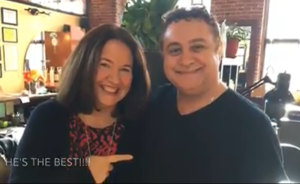Be Fausto (Have Gratitude as an Intention and a Process)
 Leaving Fausto’s chair, you will feel better. He starts with the intention that you will feel good by the time you go. When you first sit down, if he determines you are in a negative state, he’ll work harder to transform you into a positive place. He starts by intentionally shifting his state to positive. Then he listens. He offers suggestions and alternatives to help the person understand that there are options, and he reassures you that it’s not the end of the world (his words).
Leaving Fausto’s chair, you will feel better. He starts with the intention that you will feel good by the time you go. When you first sit down, if he determines you are in a negative state, he’ll work harder to transform you into a positive place. He starts by intentionally shifting his state to positive. Then he listens. He offers suggestions and alternatives to help the person understand that there are options, and he reassures you that it’s not the end of the world (his words).
As he’s offering insights, he is acting as your champion and saying things like I believe in you, and you can do it.
This is the magic of Fausto; he transforms people and their hair one person at a time. He has an intention and process for shifting those in his chair. He is a spreader of gratitude, a hair stylist, and an opera singer. You can find Fausto at Merlin’s in Manchester.
Gratitude alone is not the answer. Gratitude is the foundation for successful leaders. Gratitude makes solutions more innovative and sustainable. Gratitude’s benefits extend in many directions: less stress, more happiness, innovation, and engaged teams. Science proves that gratitude is contagious. A strong foundation of gratitude transforms. Each person applies gratitude differently in their life.
Here is part one of the things that grateful leaders do. These simple things create a deeper foundation of gratitude that accelerates your success. This list was curated from interviews and my experience.
- When you notice someone doing well, tell them. Out loud!
When you see someone doing something well, something you want more of, reinforce it by acknowledging it out loud and in that moment. If speaking up with a constructive dissenting view about a potentially severe issue is necessary, say it now. Example: Thank you for speaking up.
- Be specific with appreciation and give SMART gratitude.
Saying thank is good. Better is being specific about why you are saying thank you. SMART gratitude is a tool to help give particular gratitude. It is an acronym for Specific, Measurable, Authentic, Realistic, and Timely. Include details, like facts or time-based references. This will make it easier for others to understand your appreciation and repeat the behavior. Please don’t fake gratitude. Faked gratitude may backfire and cause mistrust. When you get specific, it also helps you appreciate them more. Example: Thank you for speaking up with a dissenting view on ABC in yesterday’s team meeting.
- Be strategic in appreciation by referencing relevant beliefs.
Saying thank you is good. It is better to include saying why you appreciate them. It could be a strategic reason, part of a vision, a belief, or a value. Example: I appreciate you speaking up with a dissenting view; it allows us to see the bigger picture and what others might think.
Here’s a video example, Will Smith hitting Chris Rock at the Emmys
- State the obvious to you. It may not be to others.
What’s obvious might be only to you. Say what you are doing and why, so others can follow along and understand. For example, I believe in testing for these five days before giving them to customers because, from experience, we know the impact of not doing this testing is tenfold the cost in the field. Leaders resist this. If not done correctly, it feels like you are belittling or speaking down. You can even say, I’m talking out loud about what I’m doing to ensure we are on the same page. When done correctly, leaders are surprised at the assumptions uncovered.
- Notice who is not participating and engage them.
In a meeting, have a silent subprocess that actively scans who is not participating. You can call on the unengaged by name, Sarah – What do you think? If it’s a significant issue, create processes requiring everyone to respond.
- Create easy appreciation processes and rituals.
Create regular local appreciation rituals and processes for your team or 1x1s. Don’t overcomplicate them; make them fun and easy. Here are a few simple ideas from leaders:- At the end of each staff meeting, publicly recognize a person whose contribution and behaviors best match the desired culture.
- Regular reports include a thank you to a team member.
- Here are 37 ideas: 37 Employee Appreciation Ideas, Your Staff, Will Love | When I Work
- Be approachable, visible, and active.
Be that person to people who tell uncomfortable things too. Start with an open and inviting conversation. In USA business culture, gentle eye contact, a warm, inviting smile, a relaxed posture, and a genuine interest in the other makes people more comfortable and create a personal connection. Part of being approachable is being easily accessible and responsive to communications.
- Model and master techniques to quickly shift to gratitude.
Grateful leaders acknowledge all their emotions, positive and negative. The challenge is keeping a positive environment is what they do next after solid feelings, like anger. They know how to regulate their emotional responses for the good of themselves and their teams. Learn to shift to gratitude so you can handle the situation, no matter how challenging. Handling challenges from gratitude are more sustainable and innovative.
- Make giving and receiving feedback a regular activity.
Grateful leaders create a learning environment that is continuously improving. The primary way to improve is to seek out feedback actively, understand it, and apply improvements. Giving and receiving helpful feedback can be learned. We offer ten tips: Leading: Creating High Performing Teams, 10 Tips for Giving and Receiving Feedback, Part 1 – YouTube.
- Vent privately with trusted colleagues.
If a leader talks trash about somebody, who’s to say they’re not doing that about you? If it’s a performance issue, privately work with the appropriate people. Gratitude is easy, and it can be hard to do. The benefits are transformational and lifelong. Contact us to work with you to ramp up your gratitude at work. Star leads workshops, coaches leaders, and is a professional speaker.
 Warning: These behaviors won’t work to build gratitude unless the gratitude is genuine. Gratitude can be faked, which can lead to distrust.
Warning: These behaviors won’t work to build gratitude unless the gratitude is genuine. Gratitude can be faked, which can lead to distrust.
Implementation Tip: Find the culturally accepted positive phrases that are most acceptable and resonate best. Then use them often. Instead of gratitude, sometimes the word: appreciation, recognition, and positive feedback are used.
Please send us your USA mailing address for a printed color copy of 19 things grateful leaders do (including these 10) as a daily reminder postcard. We will send you one complimentary, limited to the first 50—shipping charges outside of the USA. For multiple copies, contact us for cost.
There will be ten more things grateful leaders do next month.
Questions:
- How do you use any of these gratitude behaviors?
- Do you have a Fausto in your life, and how do they show gratitude?

